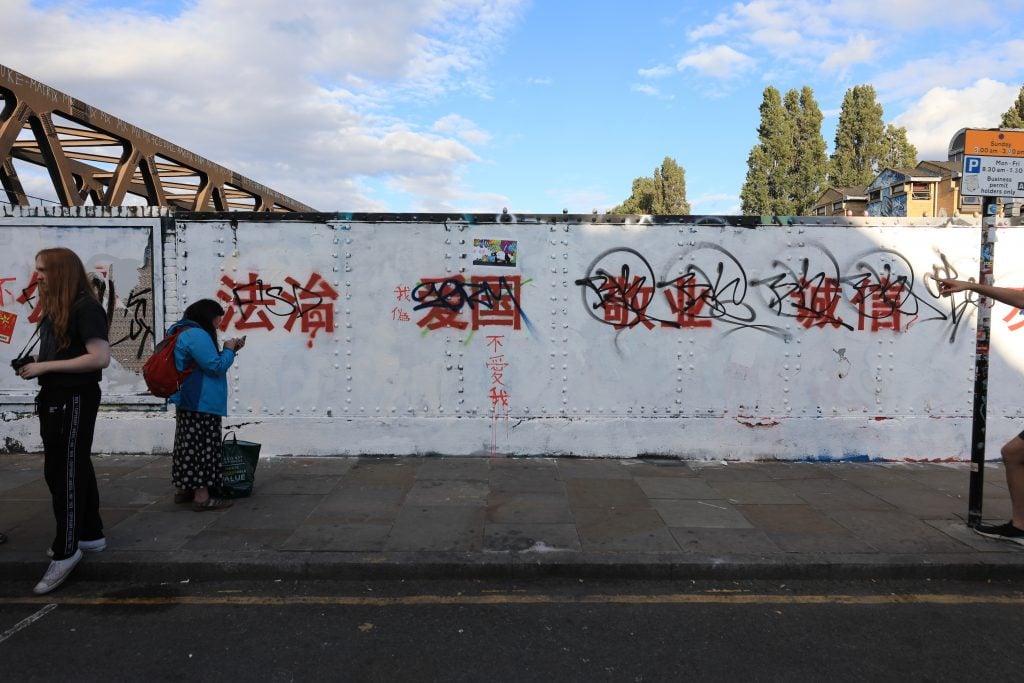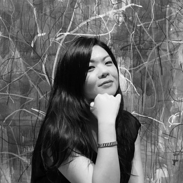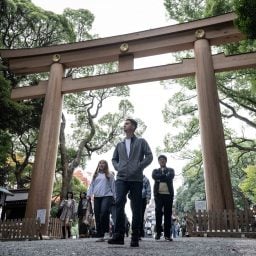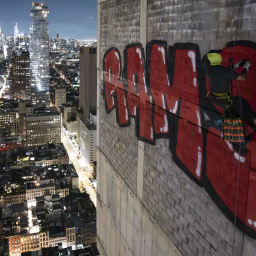Graffiti made up of 24 stenciled Chinese characters sprayed in red paint against a white backdrop across walls in London divided street art lovers and the online communities over the weekend. Some said it was China’s political propaganda and disrespectful to the street art community; others said it was a great work of art, with Ai Weiwei tweeting “like” and giving a heart-eyes emoji to what appears to be an artist statement.
The graffiti first appeared in East London’s street art haven Brick Lane on August 5. It was created a group of young people from mainland China, including several art students at London’s Royal College of Art. The group overpainted graffiti and murals on both sides of the walls with white paint, and sprayed the simplified Chinese characters in red paint.
The 24 characters referred to the 12 “core socialist values,” a set of “moral principles” that was first propagated by the Chinese Communist Party (CCP) in the 18th Party Congress in 2012, and were defined as “the soul of cultural soft power” according to the Chinese President Xi Jinping in 2014. They include “freedom,” “democracy,” civility,” “justice,” “the rule of law,” “harmony,” “prosperity,” “equality,” “patriotism,” “dedication,” “integrity,” and “friendliness.”
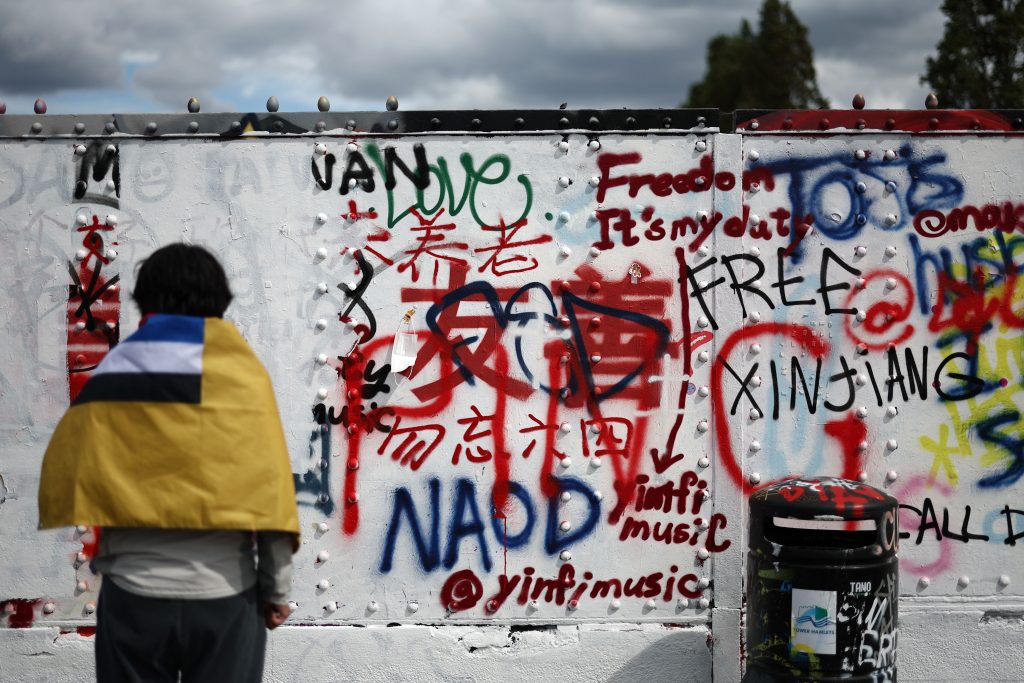
The original graffiti, which appeared in Brick Lane in East London, has since been tagged and written over, August 7, 2023. Photo by Henry Nicholls / AFP via Getty Images.
Wang Hangzheng, a student at the Royal College of Art who goes by an artist name Yi Que and the leader of this graffiti operation, dubbed the piece East London’s Core Socialist Values. He claimed on an Instagram post that the work “doesn’t have much political meaning,” but argued that freedom in the Western construct in the name of democracy is a tool of colonization and exploitation, and the freedom defined by the socialist construct is a way to counter such false freedom under Western colonization.
But soon after, images of the graffiti spread across the internet like wildfire, prompting outraged criticisms from the street art community and those from the Chinese-speaking world, including those from mainland China, Hong Kong, and Taiwan.
Many accused Wang and his crew for destroying the many street artworks including those by the late street artist known as Marty and a tribute to him by the Israeli street artist Benzi Brofman. Others said the students were “promoting a totalitarian government’s political propaganda without having the guts to mention the political implications and satire behind the “socialist core values,” wrote one Instagram user.
Street artist Susi Foxy, who has been following the incident closely, said Wang and his crew were being disrespectful and violated the unwritten rules among street artists. A street work, be it letters or murals, can be painted over when it is “tagged” by “taggers,” who operate anonymously to destroy street art, she said. “If a work is still beautiful and pristine, you avoid touching it,” Foxy told Artnet News over the phone.
“The issue is their greed over the amount of space they took. There was a wall that was already tagged, and that was fine. But they overpainted the other side which includes tributes to Marty and works by late artists. What they did was completely rude and upsetting,” Foxy added. “If they were fighting for freedom of speech, they should do it in China, not taking advantage of the U.K.. We are not arresting people for [having] different political views.”
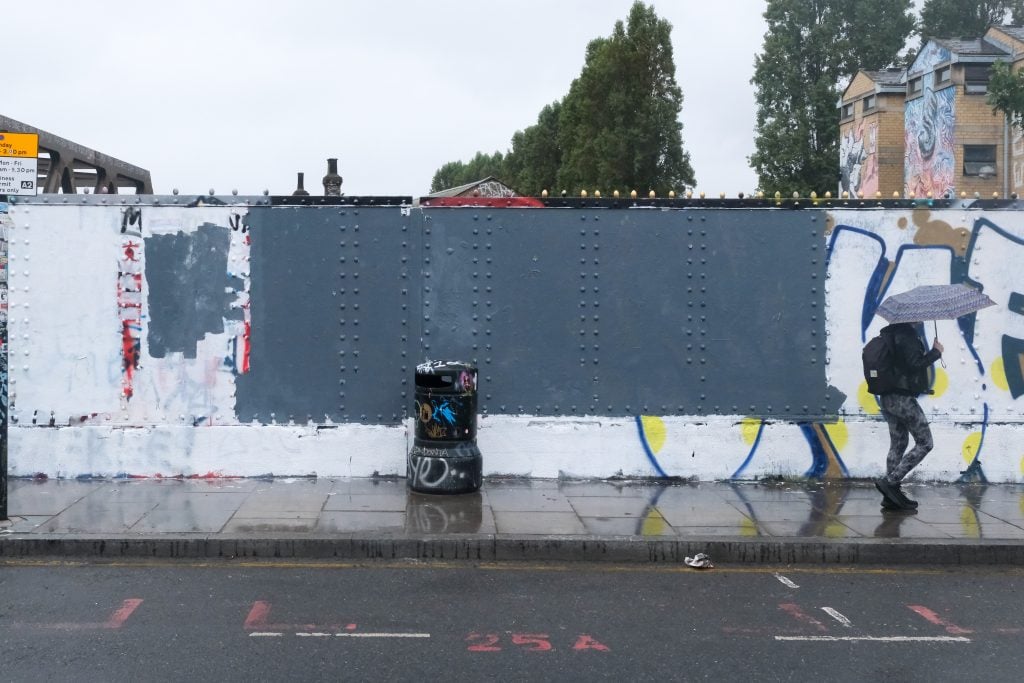
As of August 8, much of the characters and graffiti had been painted over. Photo: Matthew Chattle/Future Publishing via Getty Images.
Writing in a comment in Foxy’s Instagram post, Brofman said that he was in fact approached by one of the students from the group, who wrote to him that she loved his work. “I would lie if I say it didn’t break my heart seeing Marty’s tribute gone (especially because part of it was one of his last pieces),” he wrote.
When approached by Artnet News for comment, the artist said he did not want to waste his time and energy on this issue and wanted to focus on his future projects. “Regarding what happened at Brick Lane, my only thought is what I can do in the future to empower the amazing community that lives there and the tourists that come from all over the world,” he told Artnet News in an Instagram direct message.
Intentionally or not, the graffiti became an open canvas for anti-CCP remarks. Many went to Brick Lane to tag the work, adding their own creations and new characters to transform their meanings into the opposite, such as “freedom” into “no freedom.” Some added other protest slogans on politically sensitive topics such as the Uyghur genocide, clampdown on Hong Kong’s freedoms, the 1989 Tiananmen massacre, and China’s ongoing persecution of dissidents, and the flood that has recently destroyed the homes of tens of thousands. A sticker with slogan “No Xi Dictatorship” was slapped on the wall. As of August 8, much of the characters and graffiti had been painted over.
At the same time, netizens also launched personal attack against Wang on his social media accounts. Some even publicized his personal information online.
On August 7, Wang issued a statement on his Instagram, insisting that he had “no political stance” but declared that “I love my country very much.” But he said he needed help as he has been severely bullied online and doxxed. He also alleged that he was receiving death threats, including a bounty from an unnamed Hong Kong organization. Hundreds have left comments criticizing him for not apologizing and failing to right his wrong.
Some, however, saw the work as an accidental success. Twitter account @whyyoutouzhele, operated by a Chinese art teacher nicknamed Li Laoshi, noted that the work was executed in a “very Chinese” manner, “that is, when ‘China’ arrives, it wipes out all the splendid colorful cultures ruthlessly without any respect or consideration for others, leaving the 24-character principles that they cannot even practice themselves.”
Some overseas Chinese were worried that incident may spark hatred toward people of Chinese or East Asian descent. A London-based overseas Chinese group called China Deviants condemned Wang and his crew’s action. “Many artists and activists in mainland China are facing persecution and censorship from the government. Countless artworks and articles have been taken down, leaving only ‘404’ on the internet and empty slogans that have taken up the streets and bridges,” the statement read. The group has also created protest art on the wall, adding that they have reached out to Brofman hoping to help the artist to restore his work that was overpainted. Brofman confirmed to Artnet News that the group has been in contact with him and appreciated the gesture, but he has yet to decide what to do next.
But to Australia-based Chinese dissident artist Badiucao, the incident was more like “a stunt ripping off street artist’s space,” executed by “a group of rich and privileged Chinese nationalist students from an elite art school like the Royal College of Art,” in the name of “advocating high art concept of Marxism and decolonization,” the artist told Artnet News.
Badiucao noted that the students “will be cheered as nationalist heroes” should they return to China. “Chinese people’s urge to speak up is already there. The stunt does not generate those urges or voices. We need an open canvas in China, not London,” he said.
It was understood that Wang is about to graduate from the Royal College of Art. “We are aware of media reports regarding a current student. The College maintains high standards of integrity and we are currently making further inquiries,” a spokesperson for the RCA said in response to Artnet News.
